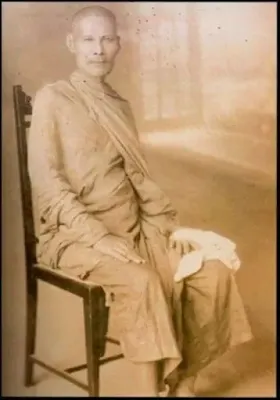Luang Pu Klin (Lp Klin) (Phra Khru Sobhon Sathanakit), Wat Saphan Sung
Biography of Luang Pu Klin (Phra Khru Sobhon Sathanakit), Wat Saphan Sung
Personal Details
- Birth: Tuesday, October 4, 1865, at 2:00 a.m. (13th waning moon of the 11th month, Year of the Ox)
- Death: Wednesday, January 8, 1947, at 1:10 a.m.
- Age: 82 years
- Monkhood: 61 years
Early Life
Luang Pu Klin, formally known as Phra Khru Sobhon Sathanakit, was born into a modest farming family in Ban Phraek Subdistrict, Nonthaburi Province. His parents were Mr. Plian and Mrs. Im Chan Plian, and he had one younger sister.
At the age of 11, Luang Pu Klin began his education, studying the Thai alphabet at Wat Tai Muang in Nonthaburi Province. By the age of 17, he was ordained as a novice monk at Wat Hong Rattanaram in Thonburi, where he studied Khmer script and Pali under Ajarn In.
Ordination and Early Monastic Life
After the passing of a close relative, Luang Pu Klin disrobed and returned to lay life. In 1883, he moved to Wat Saphan Sung, where he became a disciple of Luang Pu Eiam, the temple’s abbot.
On July 24, 1885, at the age of 21, he was ordained as a monk:
- Preceptor: Phra Ajarn Rung of Wat Thong Kung
- Sermon Preceptor: Phra Ajarn Noi of Wat Sal Lek
He received the monastic name Chan Song Si and remained at Wat Saphan Sung, dedicating himself to Vipassana meditation and traditional medicine under Luang Pu Eiam’s guidance.
Leadership and Contributions
In 1895, Luang Pu Klin was appointed abbot of Wat Saphan Sung, with unanimous support from the community and approval by Phra Preecha Chalerm (Kaew) of Wat Chaloem Phra Kiat.
As abbot, his contributions included:
- Temple Restoration: He led the restoration and gradual development of Wat Saphan Sung.
- Educational Initiatives: He emphasized education, providing teachers, study spaces, and books for young monks and students to study scriptures.
- Medical Expertise: Using traditional medicine and spiritual practices, he treated villagers and disciples, often curing illnesses with a combination of medicinal knowledge and blessings.
- Discipline and Simplicity: He established order and upheld strict moral and administrative principles in the temple.
Magical Knowledge and Spiritual Mastery
Luang Pu Klin was widely respected for his mastery of magical knowledge and spiritual abilities:
- Curved Bullet Technique: Known for his skill in bending bullets to hit targets without direct sight, a technique feared and respected by locals.
- Sacred Blessings: His blessings and rituals, including the consecration of sacred numbers and objects, were highly valued.
- Astrology: He used his expertise in astrology to guide and support his disciples.
Gratitude and Reverence for His Teacher
One of the defining aspects of Luang Pu Klin’s life was his unwavering respect for Luang Pu Eiam, his teacher. He famously avoided stepping on his teacher’s footprints, walking diagonally or to the side instead. This act of gratitude earned him immense respect from the community, who referred to him as “Luang Pu Lek”, while Luang Pu Eiam was called “Luang Pu Yai.”
Later Life and Passing
In 1947, at the age of 82, Luang Pu Klin began experiencing health issues associated with old age. On January 6, 1947, he developed severe abdominal pain, and despite medical treatment, his condition worsened. On January 8, 1947, at 1:10 a.m., he passed away peacefully in the presence of nurses and disciples.
His passing was a profound loss to his disciples and the villagers who revered him.
Legacy
- Simplicity and Wisdom: Found among his belongings was a single piece of paper inscribed with the words “Everything is not ours”, reflecting his profound humility and detachment.
- Temple Transformation: Under his leadership, Wat Saphan Sung became a center of spiritual and educational significance.
- Sacred Objects: His amulets and sacred objects remain highly sought after for their reputed spiritual power.
- Respected by Generations: His teachings, virtues, and contributions to his community have left a lasting impact.
Conclusion
Luang Pu Klin’s life exemplifies dedication, humility, and compassion. As a spiritual leader, healer, and educator, he transformed Wat Saphan Sung into a thriving temple and left an enduring legacy that continues to inspire faith and devotion among his followers. His life and teachings remain a guiding light for generations to come.


%20%E9%BE%99%E5%A9%86%E5%A4%9A%20%20Wat%20Pradoochimplee.png)
%20Pim%20Lek%20Fang%20Tarkut%20BE2523%20Nur%20Phong%20Kerson%20(108%20materials)%20Somdej%20Phra%20Yanasangwon%20(Charoen))%20Wat%20Bowonniwet%20Vihara%20blessed%20by%20Luang%20Pu%20Toh%20Wat%20Pradoochimplee%20(Grand%20ceremony).png)
%20Nur%20Phong%20Prai%20Kuman%20BE2545%20%20Luang%20Phor%20Yeam%20(Lp%20Yeam)%20Wat%20Sam%20Ngan%20%20.png)
%20%20Wat%20Khao%20Kaew,%20Nakhon%20Sawan%20Province%20(hand-inscribed%20with%20Yant%20behind)%20.png)
%20Wat%20Kositaram%20.png)
%20.png)

%20Wat%20Rai%20Taeng%20Thong,%20Nakhon%20Pathom%20Province.png)
%20Roon%20Lueng%20Samanasak%20Nur%20Thong%20Daeng%20BE2559%20Wat%20Tako%20Medallion%20for%20promotion%20of%20the%20ecclesiastical%20rank%20(code%20416).png)
%20BE2533%20Luang%20Phor%20Ruem%20Wat%20Chukkacher,%20Chonburi.png)
Comments
Post a Comment
Thank you for your comment. We will get back to you soon.